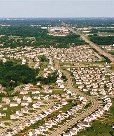
Commentary: Opportunities for Rebuilding New Orleans
Patrick Phillips, chief executive officer of the Urban Land Institute provides this commentary on land use in New Orleans five years after Hurricane Katrina left its mark on the city.
The consensus is that, on the whole, New Orleans is on the rebound.
When the Urban Land Institute advisory service panel advised the city on a revival strategy, expanding and diversifying its economy was a core piece of the recommendations for long-term sustainability. The panel maintained that a recovery plan focused on restoring “what was” rather than rethinking “what could be” would cheat New Orleans out of a chance to be more appealing, and ultimately more competitive. In the years following the storm, there are encouraging signs that the people of New Orleans have chosen “what could be.”
A Brookings Institute report points to several positives for the area’s economy:
- relatively mild job loss during the recession (the area was cushioned by rebuilding funds);
- growth of “knowledge-based” jobs;
- higher wages (a BizJournals report found that New Orleans led the nation’s metro areas in income growth in 2009);
- a growing middle class;
- continued strength in arts and cultural programs;
- improved public schools;
- and, while still significant, a decline in the number of vacant properties.
New Orleans Mayor Mitch Landrieu recently announced plans for more than 100 new public projects that will total nearly $640 million, including construction on the first portion of a $30 million riverfront park; recreational facilities, and community centers.
The proposed new medical research facility, plus the decision by a wind turbine blade manufacturer to locate in New Orleans are just two examples of how the area’s economy is evolving beyond the traditional sectors of tourism, ports, oil and gas.
The city can keep its momentum going through careful consideration of how and where it grows, so that it continues to become more accessible to residents and workers of a variety of incomes, age groups and household composition; and more responsive to growing consumer demand for energy-efficient and environmentally conscious places to live and work.
This means sticking with a comprehensive strategy for development (and redevelopment) that conserves land and reduces the need to drive ─ emphasizing development that integrates housing in a variety of price ranges, is close to employment and shopping, and is connected by transit.
Earlier this year, the Center for Neighborhood Technology released new data measuring location costs for more than 330 metro areas across the United States, including combined housing and transportation expenses, miles traveled for local trips, and vehicle carbon emissions. The housing-transportation burden for the metro area remains high, totaling at least 45 percent of the income for the vast majority of residents.
While those in the inner core drive less than 12,000 miles per year, those in the neighborhoods from just outside the core to the outlying edges drive 16,000 miles, even 18,000-plus miles per year for work and errands (nearly twice the national average), according to the center's data. While 14 percent of downtown residents use public transit, the percentage drops to 1 percent or less for the suburbs. And, not surprisingly, the households farthest from major employment nodes have the highest carbon emissions. What this shows is the impact of sprawl in the suburbs, even in close-in suburbs, and even in a city with distinct land constraints.
As New Orleans continues the rebuilding process, how its suburbs grow is pivotal. Suburban growth in the 21st century does not have to be sprawl, not in New Orleans or other urban areas. In metro areas across the United States, the suburbs are where the growth will be, and in the suburbs, less land will have to be used to accommodate more people.
The need for more housing that is close to jobs, and the link between land use, driving, and environmental preservation all make a strong case for changing development patterns throughout urban regions, in the outlying areas as well as urban cores. In many ways, New Orleans is a city like no other, but in this regard, it is no different.

Patrick Phillips, CEO, Urban Land Institute
Patrick Phillips, a longtime member of the Urban Land Institute (ULI) and a ULI trustee, has a career in the economic analysis of real estate and land use that spans more than 20 years. Prior to taking the position as the top staff executive at ULI, he was president and chief executive officer of ERA AECOM (formerly Economics Research Associates). ULI, which currently has more than 150 employees and a budget of nearly $53 million, is headquartered in Washington, D.C.